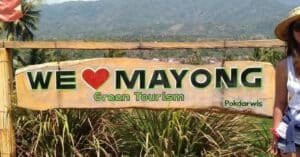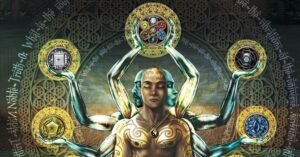Mayong is a historical village in the Morigaon district of Assam. Mayong is 47 km from Guwahati and is easily accessible via SH 3. For most outsiders, the history of Mayong is of mystery and black magic (kala jadu). In this blog, we will discuss everything about the history of Mayong from the mythological king of Narakasura to the Ahom dynasty.
About Mayong Village of Assam
Mayong is situated in picturesque surroundings. With the river Brahmaputra in the north and the river Kolong in the south, Mayong is surrounded by several numbers of small hills and hillocks towards the north, the east and the southwest of the village. Pobitora Wildlife Sanctuary is situated on the south.
Within Mayong area itself, there are two localities named Raja Mayong and Burha Mayang. Raja-Mayong is the Royal village where the king of Mayong resides at present. Burha Mayong, is believed to be the earlier settlement from where the first king of this dynasty had established his kingdom.
Origin of the Name of Mayong
The derivation of the word Mayong is pointed out to various sources by various writers, According to the manuscript containing the genealogy of the kings of Mayong, the present kingdom of Mayong was established by a Kachari king, who had come from Maibong/Maibang. That is why the kingdom came to be known as Mayong after Maibong.
According to another version the name Mayong is derived from Ma-anga, “ma” means mother and “anga” means limb. The cult of yoni worship, practiced in Assam during ancient times, is the basis of this derivation.
Another version stated that Mayong was named after Mayan, a general of king Ramapala of Bengal, in the twelfth century A.D. Mayan invades the region and established a town named Mayangarh. From Mayangarh, it became Mayong.
There is also the version of derivation of Mayong from Kachari word mairong meaning paddy, since the place was known for rich agricultural production.
History of Mayong During the Reign of Narakasur
The history of Mayong is almost synonymous to the history of the Eastern Kamrupa. The history of Mayong can be traced back to the earliest known dynasty of Assam – the Danava dynasty. It is said that Narakasura, the king of Danava dynasty, prohibited the Tantric practices in the temple of Kamakhya after he was deceived by the goddess Kamakhya in his attempt to marry her. After that it is believed that Tantric practices were carried out secretly for fear of Narakasura. It is during this period that Mayong became a centre of the secret practice of Tantra as the popular belief goes.
History of Mayong Shaped During the Cult of Nath-Jogi
The Naths or the Yogis, also known as Nath-Yogi are a prominent group in Assam. The Nath Yogis were worshippers of Siva in the phallic form, and they give importance to the practice of yoga, meditation and other occult practices. Hiuen Tsang, the Chinese pilgrim who had visited Kamarupa in the 7th century CE mentioned about presence of Nath-Yogi cult of the region. At Mayong, the Naths are mostly concentrated at the village of Rajamayong. It is during this period, Mayoung flourished as a center of black magic. People of Mayong began practice of mantras, and folk medicines. Till date, there are some well known Bez (practioners of black medicine and tribal medicine) of Rajamayong village belonging to the Nath Yogi community
History of Mayong During Kamata Kingdom
In 1257 CE, King Sandhya shifted the Kamrupa kingdom from Kamrupa to Kamatapur. As he shifted the capital towards the west of Kamrup, there was a power vacuum in the middle Assam (Nagaon region). As a result, Mayamatta, the grand son of Ratna Pala of Pal dynasty, established his petty kingdom near Mayong. It was known as Mayapur. It is said that the name ‘Mayapur’ become ‘Mayong’ as time progressed. According to some diiferent version of history, Mayamatta is regarded to be the founder king of Mayong kingdom. However, the kingdom did not last longer.
Mayong During Koch and Bhuyans’ Rule
It appears that during Durlabh Narayan’s reign (1330–1350) some families from places, as far as Kanauj in central India, were settled by him in Mayong area where the authority of the Kamata kings was weak. As a result, the whole area from Mayong-Kajali to Kaliabar was ruled by the Bhuyans (cheifs settled by Durlabh Narayan) during 15th century. One Kajali Bhuyan was the chieftain of the Bhuyans during their rule.
After the Bhuyan Chiefdom, the powerful king of Assam, Arimatta (1365-1385), a descendant of the Pala dynasty is also said to have subdued all the Bhuyan chieftains in the eastern part of Kamrupa and founded several petty kingdoms across Assam and Mayong was one of such petty kingodms.
Arimatta was killed by a Kachari king named Jangalbalahu at Kajalimukh, an importnat historical place near Mayong.
Do you know Mayong still has a traditional king? Although he does not possess a monarch’s power and authority, he is a revered figure in the society.
The present kingdom of Mayong was established in 1624 (some histories say the year is 1538) A.D. by Sunyat Singha, a Koch-Kachari king who migrated from Maibang area of Dima Hasao district of Assam. The place by the side of the Mayong hill which is supposed to have been the place where Sunyat Singha first settled came to be known as Burhamayong. The plain area to which he had shifted in search of a more convenient place came to be known as Dekamayong which later was renamed Rajamayong.
Since 16th century onwards till date, Mayong has been ruled by descendants of Sunyat Singha as a petty kingdom. The successor kings of Mayong aligned with either Koch dynasty or with Ahom dynasty, considering who holds their sway over central Assam.
History of Mayong During the reign of Ahom Dynasty
In Ahom history, Mayong is referred to as a feudatory kingdom under the Ahoms. Many petty kingdoms including Mayong existed as independent political units and enjoyed complete autonomy in its internal administration. The Ahoms maintained friendly relations with these vassal kingdoms and each vassal raja was bound to furnish a stipulated number of paiks (corvee labour of the Paik system) to work on the king’s account, or pay the commutation money if exemption from personal service. In case of war the vassal Raja was expected to render personal service.




